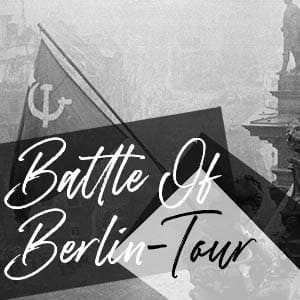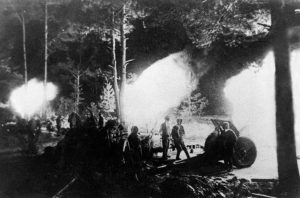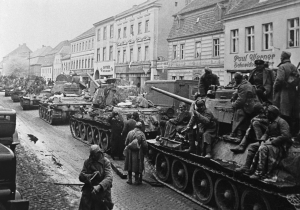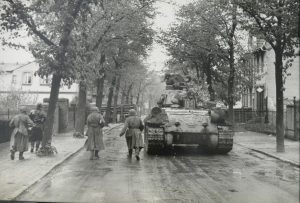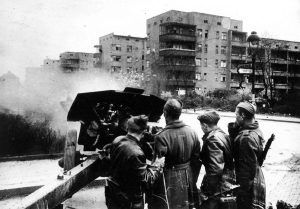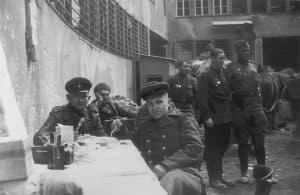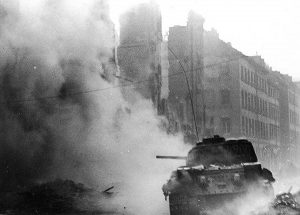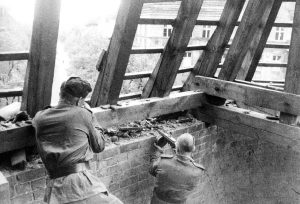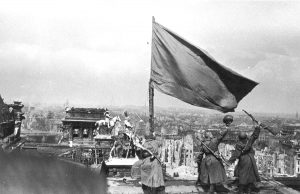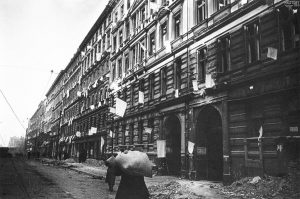By the early hours of April 30th, General Weidling – Commandant of the Berlin Defence Area – had informed Hitler in person what had already occurred to him the previous day. That the fight in the city was almost over and that the defenders would probably exhaust their ammunition sometime in the evening.
Hitler would finally concede to authorising a breakout of forces from the encircled city at 10pm – allowing some in his close entourage to relieve themselves of their commitment to the sinking ship.
The problem for these potential escapees was where it would be possible to break the Soviet encirclement of the city.
The question of direction being a little simpler to answer: West, and away from the Red Army advance.

To the south-west of the city, connecting Berlin to neighbouring Potsdam, the Glienicke Bridge had been maintained – in the hope that it would serve as an entry point for the relief forces of General Wenck’s 12th Army. An army that would never arrive in Berlin. Sometime on April 30th, the bridge was finally destroyed – whether by German explosives or Soviet fire is still unclear.
The crooked advance of the Soviet forces into Berlin had left some areas of the city in much better condition than others – as the damage inflicted on the city would vary greatly from block to block, with some areas reduced entirely to ruin and others visited by only minor damage. Some small corridors did still exist through the Soviet frontlines that would be exploited over the coming days by the remaining defenders of the city – and some of Hitler’s entourage – once it became clear that the Führer had abandoned his post.
While the events of April 30th 1945 in the Führerbunker are still disputed – the cast of characters in attendance and their various roles has been relatively well confirmed through documentation, interrogation, and interviews.
Hitler’s final day started at around 6am, when his trusted valet, Heinz Linge, discovered the Nazi leader sat on his bed, already fully dressed, when he arrived at his room in the Führerbunker for the customary wake-up-call. Thirty minutes later, Hitler would ascend the steps of the bunker towards the Chancellery garden to see the sun once more. As he approached the door, shelling began outside, and he would instead turn around and return to his quarters.
Summoning Party Secretary, Martin Bormann, to his room around 12:30pm, Hitler would explain his plan to take his own life – along with his wife ‘Fraulein Braun’ (Hitler would never refer to her as Frau Hitler) – and that he had instructed his bodyguard Otto Günsche to cremate the bodies. Bormann had earlier made every attempt to persuade Hitler to escape to Obersalzberg, but in vain.
The Nazi leader would then discuss the situation with his bodyguard, Günsche, and tells him that the time had come and that his chauffeur, Erich Kempka, should bring the petrol to burn the bodies immediately.
After eating his final meal – prepared by his personal chef, Constanze Manziarly – a dish of spaghetti with a cabbage and raisin salad at 1pm, Hitler would gather the staff members in the Führerbunker to say goodbye. Among them, Martin Bormann, Joseph and Magda Goebbels, and Hitler’s secretaries. Traudl Junge would later comment that upon shaking Hitler’s right hand she realised he was looking right through her.
At around 3:30pm, the noise in the bunker would be punctuated by the sound of a single gunshot.
Suicides in Berlin had reached a peak in April 1945 – with nearly 4,000 registered cases – more than any other month the Nazi party was in power. On April 30th 1945, Nazi leader Adolf Hitler and his wife, Eva, added their names to that long list.

Otto Günsche would stand guard outside Hitler’s office, as the Nazi leader took his life alongside Eva. Also waiting outside were Goebbels, Bormann, and some other staff. Traudl Junge, Hitler’s secretary, was in the upper bunker corridor when she heard the sound of a gunshot, to which Helmuth Goebbels’ would loudly exclaim: “Bullseye!”.
“Bormann went in first. Then I followed the valet Linge. Hitler was sitting in a chair. Eva was lying on the couch. She had taken off her shoes and placed them neatly together at one end of the couch. Hitler’s face was covered in blood. There were two guns. One was a Walther PPK. It was Hitler’s. The other was a smaller pistol he always carried in his pocket. Eva wore a blue dress with white collar and cuffs. Her eyes were wide open. There was a stench of cyanide. The smell was so strong that I thought my clothes would smell for days – but this may have been my imagination.” – SS Colonel Otto Günsche, Hitler’s bodyguard
Three SS guards and valet Heinz Linge would then carry Hitler’s body to the Chancellery garden, as Martin Bormann lifted the body of Eva Hitler, covered in a blanket out into the corridor where Erich Kempka carried her to the stairs before Günsche took over.
Chauffeur Kempka then arrived with petrol and the bodies were placed in a shallow depression outside the bunker, near an abandoned cement mixer. Joseph Goebbels’ would produce a box of matches, whereupon Linge lit some paper to create a torch and set fire to the bodies.
As the funeral party returned to the safety of the staircase, a final Heil Hitler was shouted, arms raised, before they descended again into the underground purgatory of the bunker.
“(Even after the bodies were burned), we were imprisoned by the very presence of Hitler again. We could not get away from it (the smell). It smelled like burning bacon.”
Erich Kempka, Hitler’s chauffeur
Sitting next to Traudl Junge, shortly afterwards, Hitler’s bodyguard Otto Günsche would grab a bottle of schnapps from her hand and confess: “I have carried out the Führer’s last order. His body has been burned.”
At around 6:30pm, two Waffen SS officers (Ewald Lindloff and Hans Reisser) managed to partially cover up the shallow bomb crater full of remains with dirt. It had been more than 2 hours since the bodies were brought to the surface, and the SS men would have to return to the remains with more petrol at least once to reignite the fire and complete the job.
Subsequent interrogations would suggest around 200 litres of petrol was used.
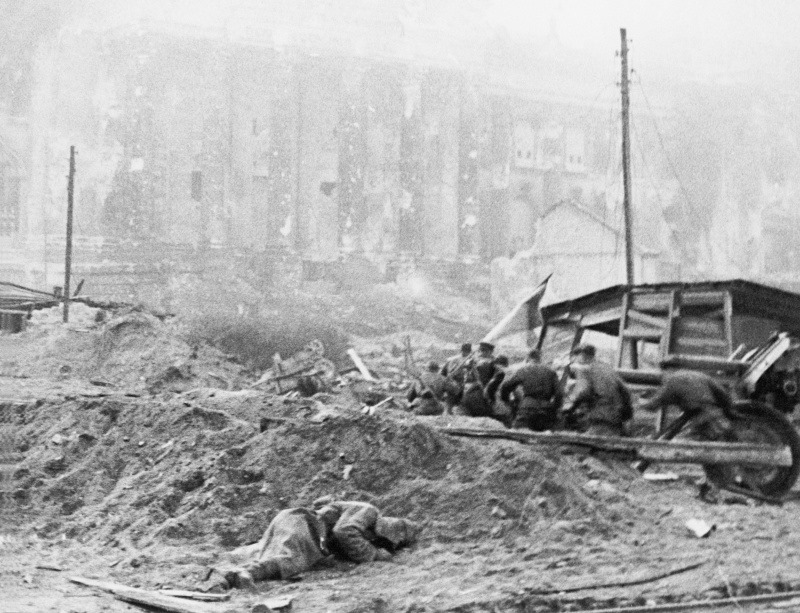
Meanwhile at the Reichstag building, the battle to take the key objective in the city would continue.
- Units of the 171st Rifle Division (the 380th, 525th, and 783rd Rifle Regiments) had crossed the Möltkebrucke, which had been so fiercely contested the previous 24hrs, before flanking east – following the river Spree to attack the Reichstag from the north.
- The 150th Rifle Division (469th, 67th, and 756th Rifle Regiments) managed to push south across the Königsplatz square in front of the building to carry out a frontal assault.
- The 207th Rifle Division (594th 597th, and 598th Rifle Regiments) would push southwest past the Kroll Opera House and onto the Charlottenburger Chaussee boulevard, leading to the Brandenburg Gate, to secure the right flank of the parliament.
After three assaults at 4:30am, 11:30am, and 1pm were beaten back with heavy losses, the Red Army brought forward tanks and self-propelled artillery to directly support the infantry.
Then Georgy Zhukov, commander of the 1st Belorussian Front, issued an Order that would add an extra element to the chaos of the situation.
Operation Order No. 6 read: “Units of the 3rd Shock Army . . . having broken the resistance of the enemy, have captured the Reichstag and hoisted our Soviet Flag on it today, April 30th, 1945, at 14.25 hours.”
This false report was sent directly to Moscow and led to war correspondents converging on the Reichstag, to find that the infantry had by this time only managed to advance halfway across the Königsplatz square in front of the building.

In response, Major General Sayanov, Commander of the 150th Rifle Division, ordered his unit to raise a flag on the building, whatever the cost.
Reports vary as to the exact timing of the the Soviet conquest, although it would appear that at around 10:50pm, Sergeants Yegorov and Kantaria – the special banner party with Red Banner No. 5 – managed to fight their way to the rear of the building and ascended a staircase to the roof. Finding a statue on the corner of the structure they wedged the flag into a crevice.
Thus signalling the acquisition of Red Army Target No. 105 – the Reichstag.
Although the flag was quickly removed by the remaining defenders – as fighting would actually continue until the late hours of the following day.

The Battle of Berlin was far from over on April 30th, as the final pockets of resistance fought fanatically and clashes continued throughout the city. However, Red Army troops instinctively knew the battle was coming to an end – and nobody wanted to be the last to die for the Reich capital – so there was some slackening of the Soviet assault.
SS General Mohnke, commander of Defence Sector Z, would report on April 30th that Soviet troops had managed to take the Hotel Adlon on Pariser Platz – only 500m from Hitler’s bunker – and were in the U-bahn tunnels of Friedrichstrasse. His assessment was only partially correct – as the Adlon remained in German hands at that time, and the underground tunnels were still unoccupied at Stadtmitte – opposite Vossstrasse and Hitler’s Chancellery.
Fighting continued at Alexanderplatz throughout the day, as the Red Army finally managed to take the Börse S-bahn station, reaching the Charité hospital and the heavily defended telegraph office on Oranienburgerstrasse. Advancing from the east, Soviet rifle divisions claimed Museum Island with the Pergamon Museum and Berlin Dom by the evening, but were stopped at the Reichsbank after receiving heavy fire from Spanish Bataillon Fantasma fighters located in buildings on the far side of the Kupfergraben canal.
Facing bitter resistance, the troops of the 1st Ukrainian Front continued to push through the west of the city – attacking in the direction of Savignyplatz – but generally made slow progress. Exhausted and disheartened by the inter-front boundary change issued by the Soviet Stavka high command on April 28th that denied Konev’s soldiers the opportunity to take the Reichstag.

The Zoo Flak tower continued to plague Soviet ground units with its guns throughout April 30th – as the district of Charlottenburg in the city’s west remained one of the few areas with substantial resistance and German defensive lines.
Even at this stage of the battle, new fortifications were being prepared – such as a tank barricade built by Dutch slave labourers north of Spittelmarkt on Kurstrasse. Although construction was interrupted by the arrival of the Soviet 11th Tank Corps, forcing the Dutch workers to scatter and hide in a nearby factory.
The Eden Hotel in west Berlin and Kempinski were by this time full of inebriated SS men – drinking liquor and eating food found hidden in the establishments.
The city boiled like a witch’s cauldron. The visions of shell shocked and sleep deprived defenders who would hallucinate and report Soviet troops everywhere only adding fuel to the fire. For some, pouring alcohol on this blaze was the only way to cope.
Rumours of an imminent rescue by the 12th Army, led by General Wenck, continued to spur the city’s defenders on – with an announcement made from the Propaganda Ministry on April 30th to that effect. By late afternoon, some units were receiving rumours of Hitler’s death – with some commanders deciding to release their men from duty and allow them to attempt to make their way out of the city.

On April 30th 1945, Soviet scouts belonging to the 199th Smolensk Infantry Division of the 49th army of the 2nd Belorussian Front, finally arrived on motorcycles at the Ravensbrück Concentration Camp for women, some 90km north of Berlin. As there were still German army men in the area holding positions with machine guns, the liberation of the camp would take another two days – with the prisoners left to fend for themselves.
While liberation would bring freedom for the women of the camp; it also brought many cases of rape at the hands of their liberators.
The price Berliners would pay for their liberation was still being calculated.
–
Taking over from the now deceased Nazi leader, Joseph Goebbels would insist on countermanding Hitler’s authorisation for a breakout from the Führerbunker – placing all plans on hold for 24 hours.
He would instead attempt to negotiate with the Soviets for the survival of the Nazi system – with Berlin and its millions of inhabitants as a bargaining chip.
**
Our Related Tours
Want to learn more about the Battle of Berlin? Check out our Battle of Berlin tours to explore what remains of this important urban battlefield.
To learn more about the history of Nazi Germany and life in Hitler’s Third Reich, have a look at our Capital Of Tyranny tours.
Bibliography
Beevor, Antony (2003) Berlin: The Downfall 1945 | ISBN 978-0-14-028696-0
Hamilton, Aaron Stephan (2020) Bloody Streets: The Soviet Assault On Berlin | ISBN-13 : 978-1912866137
Kershaw, Ian (2001) Hitler, 1936–1945: Nemesis | ISBN 0-393-04994-9
Le Tissier, Tony (2010) Race for the Reichstag: the 1945 Battle for Berlin | ISBN: 978-1848842304
Le Tissier, Tony(2019) SS Charlemagne: The 33rd Waffen-Grenadier Division of the SS | ISBN: 978-1526756640
Mayo, Jonathan (2016) Hitler’s Last Day: Minute by Minute | ISBN: 978-1780722337
McCormack, David (2017) The Berlin 1945 Battlefield Guide Part I the Battle of the Oder-Neisse | ISBN: 978-1781556078
McCormack, David (2019) The Berlin 1945 Battlefield Guide Part II The Battle of Berlin | ISBN: 978-1781557396
Moorhouse, Roger (2010) Berlin at War | ISBN: 978-0465028559
Ryan, Cornelius (1966) The Last Battle | ISBN 978-0-671-40640-0
Sandner, Harald (2019) Hitler – Das Itinerar, Band IV (Taschenbuch): Aufenthaltsorte und Reisen von 1889 bis 1945 – Band IV: 1940 bis 1945 | ISBN: 978-3957231581
Shirer, William L. The Rise and Fall of the Third Reich | ISBN 978-1451651683.

